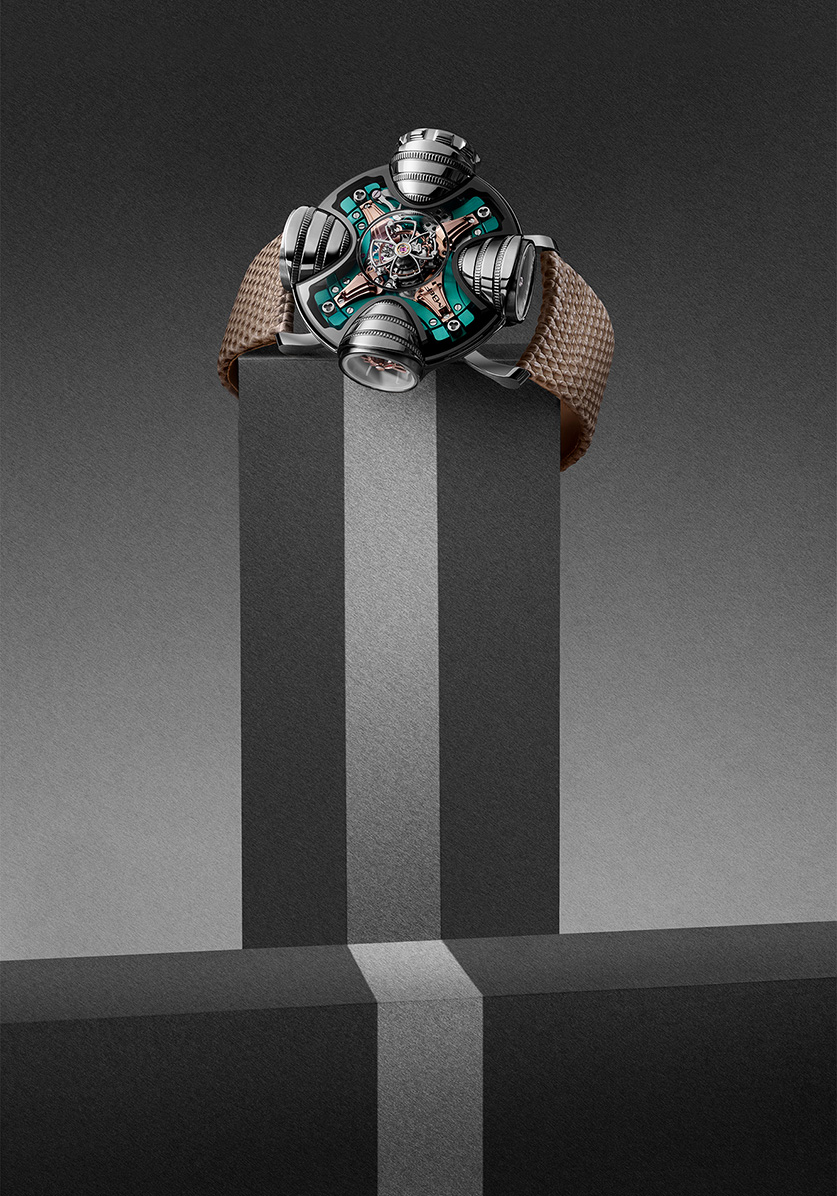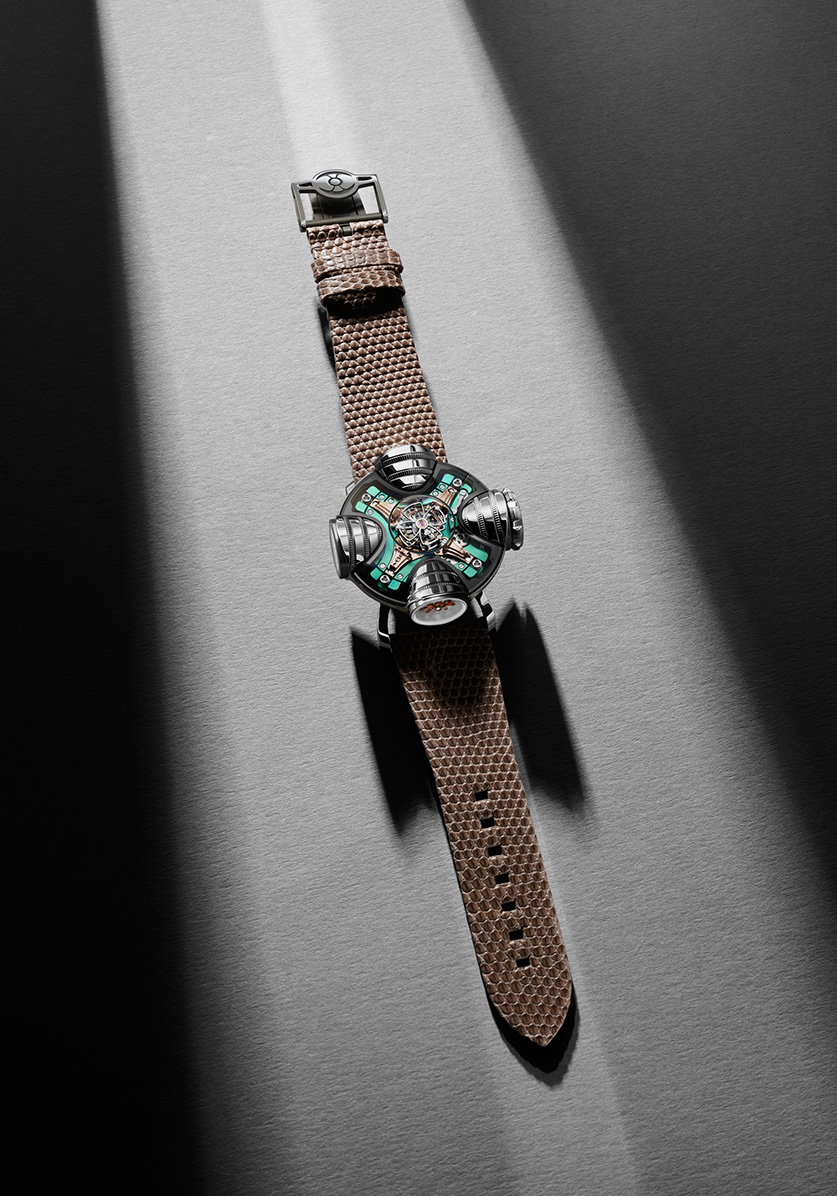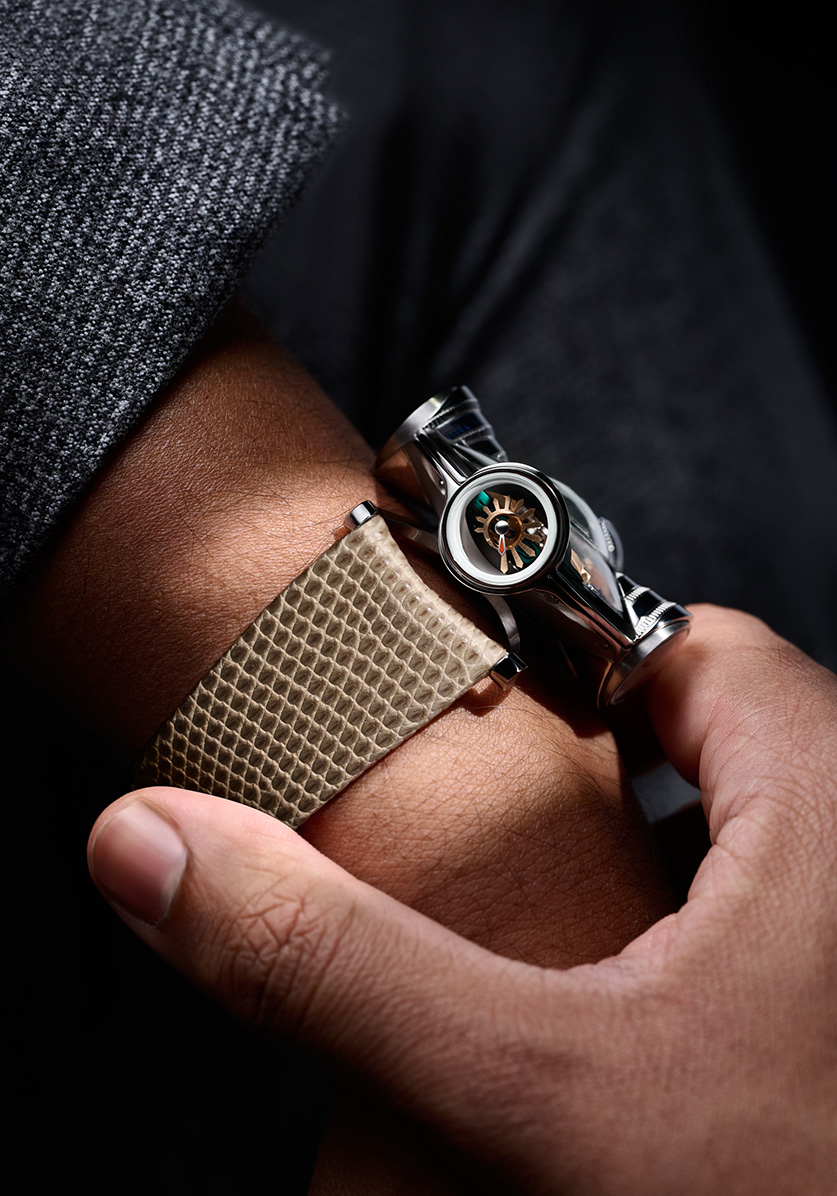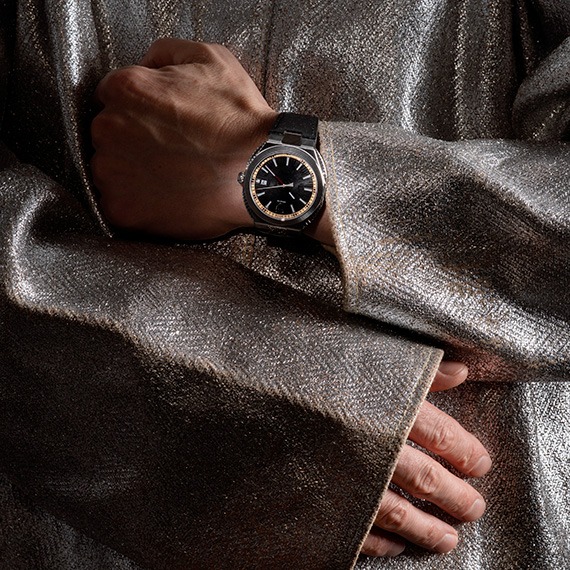
HM11 Architect & HM11 Art Deco
Blurring the lines between horology and architecture
2023 saw the rise of HM11, a hybrid mixing complex watchmaking and architecture, straight out of the brains of MB&F creative director Maximilian Büsser and designer Eric Giroud; its curves were inspired by the neo-futuristic architecture of the 1960s and 70s. For the 2025 HM11 Art Deco editions, designer Maximilian Maertens has added distinct design elements from the 1930s movement.
HM11 Architect
“A house is a machine to live in”: Le Corbusier’s quote has followed MB&F for years because its Horological Machines are not simply worn; they are inhabited. They invite a person to step into a story, sometimes a different time, sometimes a world that never existed. The first Horological Machine N°11 took that idea and made it literal. The object on the wrist became a small design house, complete with rooms, an atrium, corridors and a front door. The result was not a traditional case with a dial but a micro architecture that happened to keep time.
The introductory HM11 Architect arrived in 2023, but the seed of the design goes back further, to the late 1960s and early 1970s, an era when a few radical architects began shaping buildings organically. They produced houses that looked as if the earth had exhaled them: forms swelled and curved, volumes wrapped around sightlines and limbs. It was human in the most direct way, not through theory but through shape and scale. Maximilian Büsser looked at these organic homes and thought: what if a house was a watch?
The answer became the HM11 Architect. A central flying tourbillon rose under a double domed sapphire roof. Its quatrefoil-shaped upper bridge called to mind clerestory windows. From that centre, four symmetrical volumes reached outward to become the rooms of the house. The four rooms were not metaphors: each one carried a specific function and could be placed either directly in front of the wearer or offset by 45 degrees, simply by rotating the case. Orientation was a choice, not an obligation.
The time room delivered the essential: hours and minutes were displayed with a clarity that felt almost domestic. Rod mounted orbs served as markers: larger and lighter aluminium orbs marked the quarters, while smaller and darker titanium orbs completed the ring. The next room housed the power reserve: five orbs increased in size as the barrel filled, with a polished aluminium orb of 2.4 millimetres indicating full power. Another room installed a thermometer, not an electronic sensor but a mechanical system using a bimetallic strip. The range covered -20 to 60 degrees Celsius, or zero to 140 Fahrenheit, as preferred by the owner. The final room looked empty, a void with a small badge carrying the MB&F battle axe emblem. That quiet space was the time setting module. Pulling the transparent unit opened the door with a click,turning it moved the hands. The crown was the key to the house.
Winding did not happen at the crown, but thanks to the entire case turning on its foundations. Each 45-degree clockwise rotation clicked under the fingers and delivered exactly 72 minutes of power to the barrel. Ten complete turns produced the full autonomy of four days (96 hours). The sensation surprised many first-time wearers: the act of winding became a twist of an object rather than the tiny movement of a fingertip. The bond between owner and machine deepened through touch. It felt playful, and at the same time it felt precise.
The 42mm case itself showed how far the house metaphor could go. Grade 5 titanium formed the outer walls of the rooms. The atrium opened to the light beneath a transparent roof built from two stacked sapphire crystal domes. The crown was sapphire as well, nearly ten millimetres across, an unprecedented feature that required special engineering. A crown of that size cannot rely on a single oversized gasket, since friction would make it unusable. The solution stacked seals like a double airlock. A total of eight gaskets supported the crown alone; adding the gaskets around the case and bezel increased the count to nineteen.
The engine under the roof was an in-house manual movement, three-dimensional in its construction and built around bevel gears. The flying tourbillon set the cadence at 2.5 hertz, or 18,000 vibrations per hour. A system dampener isolated the movement from shocks through four high tension suspension springs hidden between the engine and the lower shell. These were not simple wire coils but custom elements laser cut from a hardened steel tube with a chrome finish, a solution derived from aerospace technology.
The first HM11 launched in two editions with plates and bridges in ozone blue or rose gold tones, each limited to 25 pieces. The sense of a new species was unmistakable. On the wrist the object looked like architecture. In the hand it felt like a 1970s spaceship.
HM11 Art Deco
The next step is not a departure but a change in language: the HM11 Art Deco introduces a different voice while keeping the same foundations. The person responsible for that voice is Maximilian Maertens in Berlin. His route into the era was not academic: at sixteen he visited the Rex cinema in Paris and noticed how that building stood apart, in a city where so many entrances and façades lean toward Art Nouveau. That memory lived somewhere close and eventually became a compass point for this design. The brief that followed was clear: evolve the Architect without losing its identity.
Art Deco arrives in HM11 through structure and graphics. The dial side adopts a two-tone logic that separates rings and fields. Displays change from the initial conical rods to radiating sunbeam motifs typical of the posters from the period. The temperature display switches to a font linked to the era. The metalwork makes the message physical: bridges visible from above gain a more vertical, block-like stance; their profiles recall ornamental stonework and the measured cadence of façades. On the case, the small roof elements are reworked with fine grooves that echo the stepped profiles of skyscrapers such as the Chrysler Building. Viewed from above they feel like miniature towers; viewed in passing they introduce a vertical rhythm that sits comfortably with the sunbeam dials.
The tourbillon bridge has been redrawn so its axis connects with the larger base plate bridges: when alignment lands exactly right a clean line reads across the object and ties the architecture together. The crown gains small steps that mirror layered poster art. The changes are subtle but illustrate the approach throughout this new chapter: make many small decisions, and let the sum of them support the idea.
The difference between the two HM11 chapters becomes obvious when the watches sit side by side. The Architect feels like freshly sprayed concrete with gently rounded forms, organic and experimental. The Art Deco stands straighter and speaks in verticals and sunbeams, structured and graphic. The first reads like a humanist experiment; the second reads like a city rising, with towers and façades translated to millimetres and microns. Both share the same foundations, and both tell stories that place the wearer somewhere specific. Both are machines built to be lived.
The two new HM11 Art Deco editions are in grade 5 titanium and limited to only 10 pieces:
- with blue dial plate and 3N yellow gold toned bridges, paired with a white lizard strap
- with green dial plate and 5N rose gold toned bridges, paired with a beige lizard strap.


















